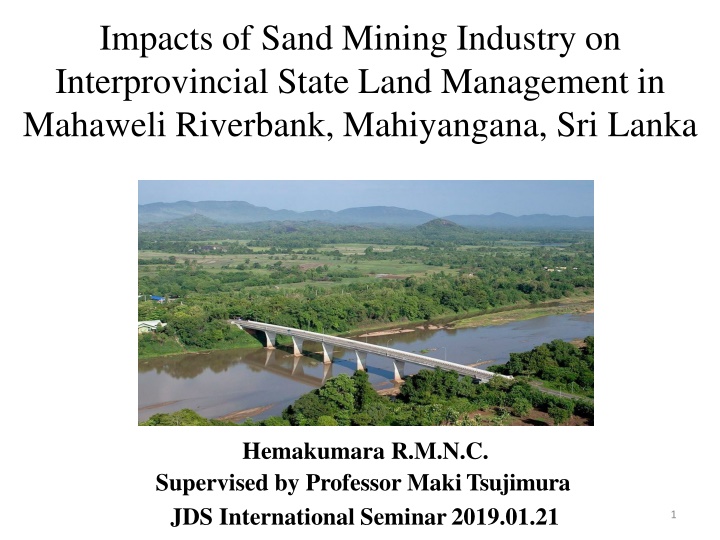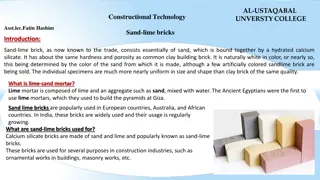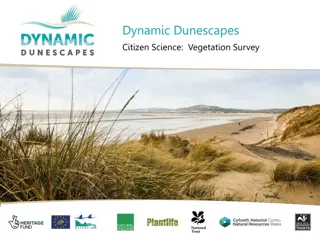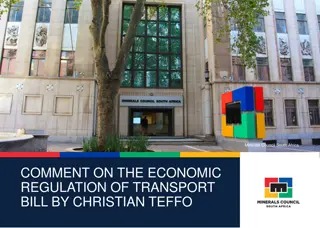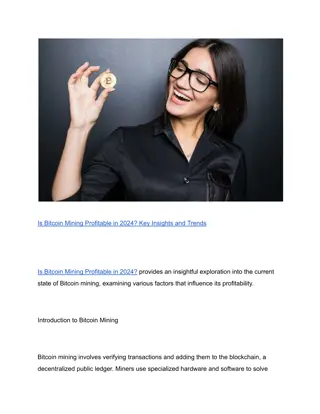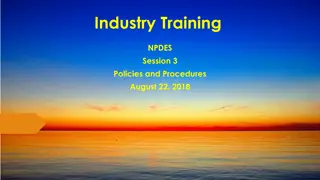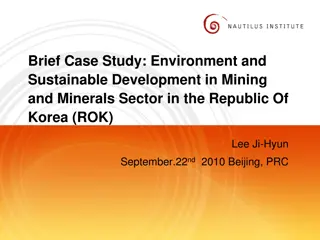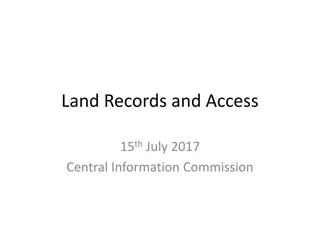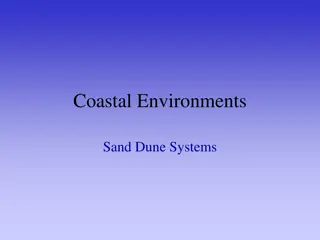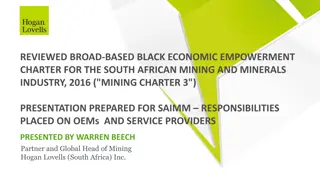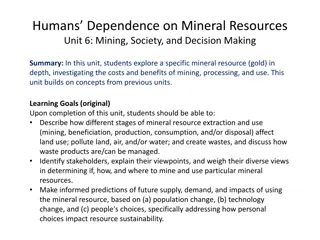Impacts of Sand Mining Industry on Interprovincial State Land Management
The study delves into the impacts of sand mining industry on land management in Mahaweli Riverbank, Mahiyangana, Sri Lanka. It explores the methods of sand mining, uses of sand in various industries, the relationship between sand mining and land management, issues surrounding sand storing land, and the associated legal and economic implications. The research highlights the challenges and consequences of sand mining activities on the environment, economy, and society.
Download Presentation

Please find below an Image/Link to download the presentation.
The content on the website is provided AS IS for your information and personal use only. It may not be sold, licensed, or shared on other websites without obtaining consent from the author.If you encounter any issues during the download, it is possible that the publisher has removed the file from their server.
You are allowed to download the files provided on this website for personal or commercial use, subject to the condition that they are used lawfully. All files are the property of their respective owners.
The content on the website is provided AS IS for your information and personal use only. It may not be sold, licensed, or shared on other websites without obtaining consent from the author.
E N D
Presentation Transcript
Impacts of Sand Mining Industry on Interprovincial State Land Management in Mahaweli Riverbank, Mahiyangana, Sri Lanka Hemakumara R.M.N.C. Supervised by Professor MakiTsujimura JDS International Seminar2019.01.21 1
Introduction Sand is, Available as terrestrial and marinedeposits Natural aggregates formed by rockerosion Represents highest volume of raw material used on earth after water Terrestrial deposits - residual soil deposit, river channel deposit andflood Marine deposits - shore deposit and off-shoredeposit plain alluvial deposit (Gavriletea et al2017) Methods of Sand Mining River bed and flood plain mining common method in SriLanka Placer mining use of water to separate heavy/lightminerals Coastal mining Open pit mining Surface mining (Piyadasa et al 2012) Uses of Sand Constructionindustry Cement industry Tile & ceramic industry Bricks & motar industry Glass & adhesiveindustry (Gunaratne et al 2010) 2
Relationship Between Sand Mining and Land Management Sand Sand Storing Sand Mining Causes Transportation Environmental and Social Issues Economic Issues LandManagement Issues Effects Land is the basicrequirement for getting a Miningpermit 3
Sand Storing Land and Land Permit Sand Storing Land Need to have a owner Owner need a relevantPermit Owner need to pay tax forLand Land Permit (Two types of permit) Land Development Ordinance (LDO) Permit Can use only for residential and agriculturalpurpose Annual Land permit Can use for commercial purposes 4
Issues of Sand Storing Land Most people have Land Development (LDO) Permit for sand storing land This is Violating prescribed conditions of LandPermit 1. Land Can not be used for commercial purposes (11th condition of the permit issuedunder section 19 (2) of the Land Development Act No 27 of 1981) 2. Land can not be sold or lease to a third party (section 46 of the Land developmentordinance No 27 of1981) Illegal activity Owner should transfer the LDO permit to an Annualpermit, If the land using for commercial purposes (Section 2 (5) Regulation 215 (6) of the Crown Land Ordinance No 8 of 1947) Decreasing inland revenue If someone use state land for commercial purpose, he needs to pay annual tax to the government (Regulation 215 (4) of the Crown Land Ordinance No 8of 1947) 5
Related Previous Studies in Sri Lanka StudyArea (River) Author Topic Focused Issues/Findings Dissanayaka C.B., Rupasingha M.S.(1996) Environmental impact of mining and sedimentation inSri Lanka Research on Gemand Sand mining (Kelani, Kalu & Nilwala rivers) Environmental impacts Soil erosion River siltation Collapse of Banks and structures Influx of saltwater RathnayakeR. (2008) A Synopsis of a series of National, provincial and local level dialogues on unregulated/ illicit river sandmining General report onall river basins Social & Economical impacts Social implication and livelihoodchange Damages to infrastructure, domesticwater supply and agriculture Piyadasa R.U.K. (2009) River sand mining and associatedenvironmental problems in Sri Lanka Nilwala river Environmental impacts Intrusion of sea water intoriver Collapse of riverbank Ground water qualitychange Gunarathna L.H.P. (2010) Policy Options for Sustainable river Sand mining in SriLanka Ma Oya, Deduru Oya & Mahaweli river Comparison of annual cost and benefit(private cost < social cost) Analysis of miners view and preferences Evaluation of expertopinion Alternatives for riversand Rathnayake R., PereiraK. (2013) Curbing Illigal Sand Miningin Sri Lanka Ma Oya, Deduru Oya Environmental, Social & Economicalimpacts Coastal and riverbankerosion Ecosystem in balancing Salt water intrusion Distrup sediment deposition Damage to infrastructure Increase health issue 6
Focused and Unfocused Issues (SriLanka) Focused Issues Environmental Issues Change the river shape, water pollution, river bank erosion, river siltation, salt water intrusion, reduce ground water table, reduce ecosystem equilibrium, distrupt sediment deposition Economic Issues reduce domestic water supply, damages to infrastructures (roads, bridges, electricity transmission towers), great impacts to small scale agriculture activity Social Issuees lower income people fall easily to illicit mining groups, uncovered pits cause health issues Mining PolicyAmendments Restriction of mining at vulnerable sites, community based management of mining industry, promoting alternatives for river sand, heavy penalty on illegal miners, rehabilitation programmes, monitoring system and composition of legal regulatory framework, networking and empowering community based organizations Unfocused Issues State Land Management Issues State Land PolicyAmendments 7
My Study Objectives To determine the Interprovincial state land management issues of sand mining industry in Mahaweli river bank, Mahiyangana Make necessary suggestions to the sand mining permit issuance process, Annual land permit issuance process, and existing land permit transferring process 8
StudyArea Mahiyangana & Minipe Divisional Secretariat 18 Grama Niladari divisions Length of Mahaweli river in study area 15 km Lands Governed by Deputy Land Commissioner office 9
Existing legal frame work Mines and Mineral act No 33 of 1992 Land Development Act No 27 of1981 Crown Land Ordinance No 8 of 1947 State Land Management Provincial Lands (Under schedule 11 of the 13th amendment to the constitution 1987) Inter Provincial Lands (Land belongs to mega irrigation projects) (Under schedule 11 of the 13th amendment to the constitution1987) Land Commissioner General Department (Land Development Act No 27 of1981) Land Commissioner General Department (Land Development Act No 27 of1981) Deputy Land Commissioner Offices (Under schedule 11 of the 13th amendment to the constitution 1987) Provincial Land Commissioner Offices (Under schedule 11 of the 13th amendment to the constitution 1987) Divisional Secretariat Offices (Land Development Act No 27 of 1981, Transfer of Power act No 58 0f 1992) 10
Current Sand Mining Permit IssuanceProcess Landowner or lessee Request letter(section 34 of the Mines and Mineral act) Geological Survey and Mines Bureau (GSMB) (section 2 of the Mines and Mineral act No 33 of 1992) Calling recommendation Deputy Land Commissioner Office Divisional Secretariat (Transfer of Power act No 58 of 1992) Central Environmental Authority (National Environment Act No 47 of 1980) Giving recommendation Geological Survey and Mines Bureau (Mines and Mineral act No 33 of 1992) GSMB do not getting recommendation from Deputy Land Commissioner Office for issuing Mining permit (Schedule 11 of the 13th amendment to the constitution1987) Issuing Mining Permit (section 35 of the Mines and Mineral act) Land Owner/Lesee 11
Current AnnualLand Permit IssuanceProcess Annual Permit requester Request letter (Crown Land Ordinance No 8 of 1947 Regulation 215 (6)) Deputy Land Commissioner Office (Section 2 (5)Regu Or dinance) lation 215 of Crown Land Forward with Recommendation Land Commissioner General Department (Section 2 (5) Regulation 215 Crown and Ordinance) Preliminary approval and calling prescribed documents Deputy Land Commissioner Office (Section 2 (5) Regulation 215 of Crown Land Ordinance) Forward fully completed documents Land Commissioner General Department (Section 2 (5) Regulation 215 Crown Land Ordinance) Issuing Annualpermit Deputy Land Commissioner Office (Section 2 (5) Regulation 215 of Crown Land Ordinance ) Charging relevant tax and issuing permit (Crown Land ordinance No 8 of 1947, Regulation 215 (4) format LC 78) Annual Permit Holder 12
Contradictions Between Sand Mining Permit & Land Permit Sand Mining Permit If the sand storage land is owned by the government, permit holder should pay the charges to the relevant institution. (4th condition of Mining Permit, Mines & Minerals Act No 8 of 1992) If the Permit holder is not the land owner, he cannot proceed mining and storage without the land owners permission. (8th condition of Mining Permit, Mines & Minerals Act No 8 of 1992) Land Permit The permit holder should not use this land for commercial purposes otherthan residential or agricultural needs. (11th condition of Land permit, section 19(2) of Land Development Ordinance No 27 of 1981 ) The permit holder should not dispose the land to any other third party .(13th condition of Land permit, section 19(2) of Land Development Ordinance No 27 of 1981) Sand Mining permit Land Permit Land usage ability for commercial purpose O Land disposition ability for a third party O 3 1
Methodology Combination of Qualitative & Quantitative approach Qualitative data interviews with targeted groups, questionnaire. Quantitative data - official records of related government institutions. 14
Quantitative Data Target Government Institutions 1. Divisional Secretariats of Minipe & Mahiyangana(DS) 2. Geological Survey & Mines Bureau of Kandy & Badulla(GSMB) 3. Deputy Land Commissioner Office of Mahiyangana(DLC) Number of sand mining permits recommended/approved ? (2008-2017) (GSMB, DS) Number of complaints/petitions received against sand mining? (2008-2017) (GSMB, DS) Number of LDO permits issued near Mahaweli river bank? (2008-2017)(DLC) Number of land disputes recorded? (2008-2017)(DLC) 15
Qualitative Data Target Groups, Sample size & Questions 1. Sand mining permit holders (54) 18 Grama Niladari divisions (3 persons from eachdivision) (No of mining Sand cubes, Monthly income & expenses, Paid loyaltytax, Awareness of permit conditions &suggestions) 2. Sand storing land owners/ Land permit owners (54) 18 Grama Niladari divisions (3 persons from eachdivision) (Land extent, Ownership of land, Mining permit owner or leaser, Awareness of sand& land permit conditions,suggestions) 3. Colonization Officers of relevant divisions (8) (Number of LDO permit holders and number of land lessee in your division?, Importance your recommendation for sand permit issuance?, Reporteddisputes related to sand mining?) 16
DataAnalysis Quantitative data Basic Analytical Methods mean, median, graphs,charts (to show the land crisis) Mathematical calculations to show how government revenue canbe increased Qualitative Data Sand miners and Land permit holders to get generalfeedback Colonization Officers to get suggestions for final results andconclusions 17
Future work Further literature survey and gather more knowledge Data collection, analysis and Interpretation 18
References Arwa G.A. (2013), Sustainable Governance for Artisanal Sand Mining - Case of Kangonde Location, Masinga District. Research Project presented to the Department of Geography and Environmental studies, University of Nairobi, in partial fulfillment of the requirements for the Award of the Degree of Masters of Arts in Environmental Planning and Management. http://erepository.uonbi.ac.ke/bitstream/handle/11295/60467/Arwa_Sustainable%20Governance%20For%20Artisanal%20Sand%20Mining%20%20Case %20Of%20Kangonde%20Location%2C%20Masinga%20District.pdf?sequence=3&isAllowed=y Bogdanov V. L., Ryabov Yu. V., Burlakova M. K. (2017), Land Use Policy and Land Management in Estonia. Baltic Region; 9(1):91-104 DOI 10.5922/2079-8555-2017-1-8, https://journals.kantiana.ru/eng/baltic_region/ Farahani H, Bayazidi S. (2018), Modeling the assessment of socio-economical and environmental impacts of sand mining on local communities: A case study of Villages Tatao River Bank in North-western part of Iran. Resources Policy, Volume 55, Pages 87-95, https://doi.org/10.1016/j.resourpol.2017.11.001 Gavriletea, Dan M. (2017), Environmental Impacts of Sand Exploitation. Analysis of Sand Market. Sustainability; Basel: DOI:10.3390/su9071118 Gunaratne L.H.P. (2010) Policy Options for Sustainable River sand mining in Sri Lanka, Chapter from book Cost-Benefit Studies of Natural Resource Management in Southeast Asia(pp.201-223), DOI:10.1007/978-981-287-393-4_10 Hussain V, Hamid G, Bilal M, Yassen R, Anjum S., (2017), Environmeental Impact of Sand Mining in Malir River BedKarachi, Pakistan. Environ. Geol. Vol. 8 (1) p.41-45 KHAN S , SUGIE A ., (2015), Sand Mining and Its Social Impacts on Local Society in Rural Bangladesh: A Case Study of a Village in Tangail District. Journalof Urban and RegionalStudieson ContemporaryIndia, 2, 1 Lei Shen, Tao Dai, Aaron J. Gunson (2009),Small Scale Miningin China AssessingRecent Advances in the Policy& RegulatoryFramework. Resource Policy 34, p.150-157. Pereira, K., & Ratnayake, R. (2013). Water Integrity in Action: Curbing Illegal Sand Mining in Sri Lanka, Berlin, Germany: Water Integrity Network. Piyadasa R.U.K., Navarathna C.M., (2011), River Sand Mining in Southern Sri Lanka and its Effect on Environment. International Association of Hydrological Sciences, IAHS-AISH publication, p.148-153. Senarathna A. (2017) Evolution of Land Policy in Sri Lanka, http://www.ips.lk/images/News/2017/31_03_2017_Land/Athula_LandPolicy_IPS.pdf Syah P.R.I., Hartuti,Purnaweni,(2018),Land Use and River DegradationImpact of Sand and Gravel Mining. E3S Web of Conferences,Les Ulis:EDP Sciences. DOI:10.1051/e3sconf/20183109034 Zaharah Y., Mariani A, Sabrina A. (2018), Legislative Analysis on Quarry Rehabilitation in Selangor, Malaysia. Resources Policy, Volume 55, Pages 1-5. Crown Land Ordinance No 8 of 1947 in Sri Lanka,http://extwprlegs1.fao.org/docs/pdf/srl14839.pdf Land Development Ordinance No 27 of 1981 in Sri Lanka, http://extwprlegs1.fao.org/docs/pdf/srl13623.pdf Mines and Mineral Act No 8 of 1992 in Sri Lanka,http://extwprlegs1.fao.org/docs/pdf/srl91267.pdf Policy Report of Windhoek City in Namibia, 2017. Policy Towards Sustainable Sand Mining. http://www.windhoekcc.org.na/pdf/busi/CoW%20Sand%20Mining%20Policy%20-%20Final%20Policy.pdf Int. J.Econ. 19
